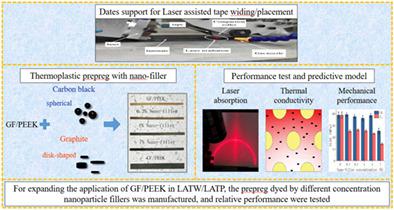当前位置:
X-MOL 学术
›
Polym. Compos.
›
论文详情
Our official English website, www.x-mol.net, welcomes your
feedback! (Note: you will need to create a separate account there.)
The effect of nanoparticle fillers on glass fiber/poly-ether-ether-ketone prepreg laser absorbance, thermal conductivity and interlayer performance
Polymer Composites ( IF 4.8 ) Pub Date : 2022-12-14 , DOI: 10.1002/pc.27208 Yanrui Li 1 , Yong Li 1, 2 , Dajun Huan 1 , Lisha Li 1 , Hongquan Liu 1 , Wuqiang Wang 1 , Junsheng Wang 1 , Chunling Zhu 2 , Ning Zhao 2
Polymer Composites ( IF 4.8 ) Pub Date : 2022-12-14 , DOI: 10.1002/pc.27208 Yanrui Li 1 , Yong Li 1, 2 , Dajun Huan 1 , Lisha Li 1 , Hongquan Liu 1 , Wuqiang Wang 1 , Junsheng Wang 1 , Chunling Zhu 2 , Ning Zhao 2
Affiliation

|
Aiming at the use of glass fiber reinforced poly-ether-ether-ketone (GF/PEEK) with low laser absorbance in laser assisted tape winding/placement (LATW/LATP), a method for dyeing GF/PEEK prepreg with nanoparticle fillers (NFs) is presented. First, the effects of carbon black (CB) and graphite (G) NFs on composites laser absorbance and reflection pattern were quantified, and the complex refractive index model was derived. Next, the effects of NFs on composites transverse thermal conductivity were tested, and the accuracy of four thermal conductivity prediction models were compared. Finally, the effects of NFs on composites interlayer performance were studied. The optical test results showed that NFs could improve laser absorbance while not changing reflection pattern, and the increase rate of absorbance for CB was higher than for G. As calculated by complex refractive index model, GF/PEEK with 1-layer thickness could achieve complete laser absorption by addition of either 2.74%CB or 3.78%G. The thermal conductivity test results showed that NFs could improve composites transverse thermal conductivity. The increase rate of thermal conductivity for G was higher than for CB. Among the four prediction model, the Lewis-Nielsen model had correct prediction regularity and was within 10% predict deviation. Based on this model, the transverse thermal conductivity of GF/PEEK/2.74%CB was 0.557 W/m K, and of GF/PEEK/3.78%G was 0.592 W/m K. The mechanical test results showed that the CB loading ≤4% had little effect on interlayer performance, while the G decreased interlayer performance. Consequently, adding CB at a low loading is a better way to realize GF/PEEK application in LATW/LATP.
中文翻译:

纳米粒子填料对玻璃纤维/聚醚醚酮预浸料激光吸收、导热性和层间性能的影响
针对低激光吸收的玻璃纤维增强聚醚醚酮(GF/PEEK)在激光辅助胶带缠绕/铺放(LATW/LATP)中的应用,一种用纳米颗粒填料(NFs)染色GF/PEEK预浸料的方法) 被呈现。首先,量化了炭黑 (CB) 和石墨 (G) NFs 对复合材料激光吸收和反射模式的影响,并推导了复折射率模型。接下来,测试了NFs对复合材料横向导热系数的影响,并比较了四种导热系数预测模型的准确性。最后,研究了 NFs 对复合材料层间性能的影响。光学测试结果表明,NFs可以在不改变反射模式的情况下提高激光吸光度,CB的吸光度增加率高于G。根据复折射率模型计算,1 层厚度的 GF/PEEK 可以通过添加 2.74%CB 或 3.78%G 实现对激光的完全吸收。导热系数测试结果表明,NFs可以提高复合材料的横向导热系数。G 的热导率增加率高于 CB。四种预测模型中,Lewis-Nielsen模型预测规律正确,预测偏差在10%以内。基于该模型,GF/PEEK/2.74%CB的横向导热系数为0.557 W/m K,GF/PEEK/3.78%G的横向导热系数为0.592 W/m K。力学测试结果表明,CB载荷≤ 4%对层间性能影响不大,而G降低了层间性能。因此,在低负载下添加 CB 是实现 GF/PEEK 在 LATW/LATP 中应用的更好方法。
更新日期:2022-12-14
中文翻译:

纳米粒子填料对玻璃纤维/聚醚醚酮预浸料激光吸收、导热性和层间性能的影响
针对低激光吸收的玻璃纤维增强聚醚醚酮(GF/PEEK)在激光辅助胶带缠绕/铺放(LATW/LATP)中的应用,一种用纳米颗粒填料(NFs)染色GF/PEEK预浸料的方法) 被呈现。首先,量化了炭黑 (CB) 和石墨 (G) NFs 对复合材料激光吸收和反射模式的影响,并推导了复折射率模型。接下来,测试了NFs对复合材料横向导热系数的影响,并比较了四种导热系数预测模型的准确性。最后,研究了 NFs 对复合材料层间性能的影响。光学测试结果表明,NFs可以在不改变反射模式的情况下提高激光吸光度,CB的吸光度增加率高于G。根据复折射率模型计算,1 层厚度的 GF/PEEK 可以通过添加 2.74%CB 或 3.78%G 实现对激光的完全吸收。导热系数测试结果表明,NFs可以提高复合材料的横向导热系数。G 的热导率增加率高于 CB。四种预测模型中,Lewis-Nielsen模型预测规律正确,预测偏差在10%以内。基于该模型,GF/PEEK/2.74%CB的横向导热系数为0.557 W/m K,GF/PEEK/3.78%G的横向导热系数为0.592 W/m K。力学测试结果表明,CB载荷≤ 4%对层间性能影响不大,而G降低了层间性能。因此,在低负载下添加 CB 是实现 GF/PEEK 在 LATW/LATP 中应用的更好方法。




















































 京公网安备 11010802027423号
京公网安备 11010802027423号